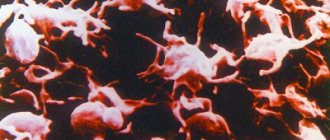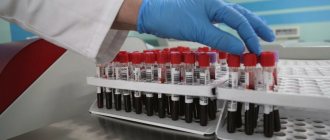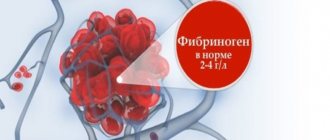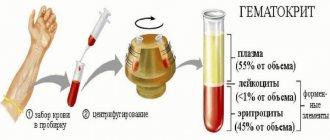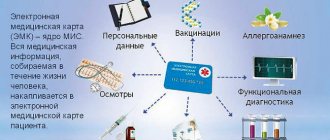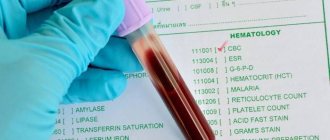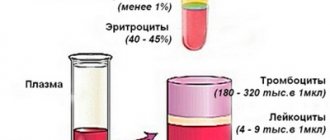Normal level of erythropoietin in the blood. Explanation of the result table
An erythropoietin test is prescribed if it is necessary to make a differentiated diagnosis of various types of anemia, especially if there are any deviations from the norm in the general blood test.
A blood test for erythropoietin allows you to find the cause of anemia and determine the severity of the process. Especially in cases where the origin of anemia is unclear. In addition, an erythropoietin test is done if you need to assess the condition of the kidneys and how successfully they cope with the production of this hormone.
Polycythemia is an excessive concentration of red blood cells per unit volume of blood. A test for erythropoietin may also be necessary in order to find out whether this pathology is associated specifically with excessive production of erythropoietin. Polycythemia can be primary or secondary. Primary polycythemia is a malignant disease, and it is in no way related to the production of this hormone; moreover, usually the concentration of erythropoietin in a person’s blood with primary polycythemia becomes even lower than normal.
Secondary polycythemia is a direct consequence of excess production of erythropoietin caused by oxygen starvation of cells due to the development of various diseases.
When a patient is diagnosed with chronic renal failure, in order to understand whether this disease affects the synthesis of erythropoietin, testing for the level of this hormone is also prescribed.
Blood is drawn from a vein in the morning on an empty stomach. It is at this time that the level of erythropoietin is normally at its maximum.
The normal level of erythropoietin in the blood of ordinary people and pregnant women:
The role of the drug erythropoietin
An analogue of a natural hormone is obtained by genetic engineering. The drug is available under the names: Recormon, Binocrit, Epobiocrin, Eprex. Administered intravenously or subcutaneously.
In sports
Under the influence of erythropoietin, the amount of oxygen per unit volume of blood increases. This leads to better tolerance of heavy physical activity, increased efficiency of the heart and lungs. Under physiological conditions, this effect can be achieved by training in high altitude conditions. In this case, the reduced partial pressure of the gas in the inhaled air triggers the formation of a natural hormone.
When using the drug, it acts as a doping and allows you to achieve high results during aerobic exercise - running, skiing, cycling, swimming.
Since not all athletes prefer a longer path to natural stimulation of the body’s reserve forces, bodybuilders began to use erythropoietin (together with insulin and growth hormone) as an alternative to anabolic steroids.
A particular attractiveness of erythropoietin is the absence of contraindications other than severe hypertension. Its therapeutic use in case of insufficient production does not cause side effects. If, against the background of normal levels, an additional hormone is administered, then the following consequences occur:
- blood viscosity increases;
- the risk of systemic circulatory and microcirculation disorders increases;
- thrombosis occurs;
- possible blockage of the pulmonary artery with fatal outcome;
- bothered by headaches;
- The need for iron sharply increases, and when it enters the body, it accumulates in the liver, leading to cirrhotic changes.
In medicine
The main indications for the use of the drug are anemia in cancer and chronic renal failure. It can also be prescribed for the following pathological conditions:
- impaired blood circulation in the kidneys due to narrowing of the arteries, atherosclerosis;
- hydronephrosis (hydrosis of the kidneys);
- oxygen starvation of tissues due to heart failure, lung diseases, heart defects;
- hemoglobinopathies (formation of defective forms of hemoglobin).
We recommend reading the article about Addison's syndrome. From it you will learn about the causes of Addison's disease, symptoms in women, men, children, general diagnostics and tests, as well as treatment of bronze disease.
And here is more information about Nelson's syndrome.
Erythropoietin is synthesized primarily in the kidneys. Its role is to stimulate the bone marrow to produce red blood cells. The main activator of hormone production is oxygen starvation. A blood level test is prescribed for suspected anemia or polycythemia, as well as for athletes during doping control.
Despite the safety of use in therapeutic doses, uncontrolled use can cause complications, some of which can be fatal.
Erythropoietin in sports
Erythropoietin has found widespread use in sports. Its synthetic analogues are used to give muscles the ability to do hard work for a long time. Drugs that thus affect the athlete’s body are called doping.
An athlete taking erythropoietin-based doping is able to run, ride a bicycle or row an oar for a long time without feeling tired. In other words, such doping has found application in those sports that require long, uniform effort. But it is not very suitable for heavyweight athletes.
Several fatalities were recorded, specifically among cyclists, after which drugs with erythropoietin were officially recognized as dangerous doping and their use was banned. All athletes found using erythropoietin were disqualified for the rest of their lives.
Doping with erythropoietin is very difficult to determine from an athlete's blood or urine test. Therefore, since 1990, anti-doping laboratories have been developing methods for detecting a prohibited drug in athletes' samples. Since the synthetic hormone, in its composition and action, is identical to the natural one, and its presence in the blood is explained by the stressful situation caused by the competition, it is extremely difficult to detect.
Therefore, it was decided not to measure the amount of the hormone in the athletes’ blood, but the level of oxygen and hemoglobin. Although this method of measurement is quite subjective, because some were calm before the start and rested the day before, while others trained for a long time and are very nervous.
Despite the controversial methods for determining doping in an athlete’s blood, the conclusion in connection with the use of a drug with erythropoietin can be made simple - its effect can be fatal.
But there is another opinion, born in the light of recent events related to sports competitions of world significance, namely the Olympics. The main thing for sports officials is not to identify an athlete who uses doping, but to remove athletes from competitions from countries with a policy that is incorrect from their point of view. And few people in such a situation are interested in what effect the drug creates on a person.
https://youtube.com/watch?v=MwJtZHaASNg
Erythropoietin in athletes
Erythropoietin can increase endurance
In the world of sports, the hormone is considered a doping, as it allows you to increase the number of red blood cells, increasing the enrichment of tissues with oxygen and thereby increasing their endurance. Because of this, quite often an artificial hormone is used to improve the condition of athletes for whom the anaerobic stability of the body is important, although this doping is prohibited. Also, long-term use of the drug is dangerous, as it causes liver damage, and an overdose causes increased blood viscosity.
Above and below normal
The concentration of erythropoietin in the blood of a healthy woman ranges from 8 to 30 IU/l; in men, these figures range from 5.6 to 28.9 IU/l. Deviations from the norm make the doctor wary and prescribe additional examination to determine the cause.
For example, if the level of erythropoietin is increased and the number of red blood cells is decreased (this despite the fact that the hormone promotes their production), this indicates the development of anemia (anemia), which provoked inhibition of bone marrow function. If, during anemia, tests show a reduced amount of the hormone, this indicates that the kidneys synthesize its production less than normal.
In addition to comparing these tests, hormones and the environment influence the increase or decrease of erythropoietin. For example, a high concentration of estrogen in the blood reduces the production of erythropoietin, while thyroid hormones, somatropin, testosterone, prostaglandins, and glucocorticoids increase it. Erythropoietin also increases due to smoking, low partial air pressure, and exposure to high altitudes.
A reduced amount of erythropoietin indicates kidney problems, primarily chronic renal failure (which is why people with this disease suffer from anemia). Polycythemia also speaks of the disease. This is the name of a malignant tumor characterized by the proliferation of all cellular elements of the bone marrow.
- blood loss;
- various forms of anemia;
- pure red bone marrow aplasia – the bone marrow produces leukocytes and platelets within normal limits, red blood cells – below acceptable limits;
- the initial stage of myelodysplastic syndrome - the disease is characterized by dysplastic changes in the bone marrow, combined with a lack of one or more types of blood cells, which can develop into acute leukemia;
- leukemia
Another reason for increased levels of the hormone is kidney disease, which produces erythropoietin. First of all, the amount of the substance increases when the blood supply to the kidneys is impaired due to shock, urolithiasis, polycystic kidney disease, or narrowing of the renal artery.
Some diseases that provoke an increase in erythropoietin cause a decrease in blood oxygen saturation. These are heart defects, congestive heart failure, and various lung diseases. Among them are chronic bronchitis, pneumoconiosis (incurable lung diseases caused by prolonged inhalation of industrial dust), chronic obstructive pulmonary disease, characterized by limited air flow in the respiratory tract.
An increase in erythropoietin in the blood can also signal the presence of a benign or malignant formation. This may be a malignant tumor of the central nervous system known as hemangioblastoma. The concentration of the hormone also increases in kidney tumors and pheochromocytoma (a tumor in the part of the adrenal cortex that is responsible for norepinephrine).
Thyroid hormone levels
Normal concentrations of thyroid hormones ensure good health and proper metabolic processes in the body. These biologically active substances are synthesized in the body of the gland and are called thyroid. Their content in the blood is strictly regulated and controlled using laboratory tests of serum.
Thyroid hormones TSH, normal
During a visit to an endocrinologist, patients are often prescribed tests for thyroid hormones, the norm of which allows the doctor to make the correct diagnosis. Blood is donated on an empty stomach, in the morning. The day before the test, it is recommended to avoid stress.
Basic tests for thyroid hormones:
- Determination of TSH. This is a thyroid-stimulating hormone that is synthesized in the pituitary gland and regulates the functioning of the thyroid gland. The norm is no more than 4.0 µIU/ml and no less than 0.4 µIU/ml. TSH is elevated when thyroid hormone production decreases. Conversely, TSH is lowered if hyperthyroidism is observed. The range of acceptable values is quite large, since normal values vary under different circumstances.
- Free T3 and T4. Moreover, T4 (thyroxine) is converted into T3 (triiodothyronine) as needed in the body, so their content in the blood changes over the course of the day. T3 is especially susceptible to fluctuations, its concentration changes depending on age, the presence of concomitant diseases, etc. It is generally accepted that this level of thyroid hormones in a free state is acceptable: T3 - minimum 2.3, maximum 6.3 pmol/l, for T4 indicator – minimum 10.3, maximum 24.5 pmol/l.
- Bound T3 and T4. This test is not often prescribed. In a protein-bound state, the hormone is not active and does not exert its biological effect. The value of this indicator is influenced by many factors not related to the thyroid gland. For example, kidney disease and taking certain medications can reduce the amount of bound hormone, while viral diseases and pregnancy, on the contrary, increase binding.
- Antibodies to thyroglobulin (TG). Thyroglobulin is a specific protein produced by the thyroid gland. Antibodies to it are present in small quantities in the blood of a healthy person. The norm is 40 IU/ml. An excess is observed with neoplasms in the gland, autoimmune thyroiditis and some other diseases. This test is prescribed after surgical treatment of papillary thyroid cancer or its complete removal has been performed.
- Antibodies to TPO, thyroid peroxidase. The medical table shows that normally this figure does not exceed 35 IU/ml. An increased content of TPO antibodies prevents the enzyme from functioning normally and provokes disturbances in the body. The analysis helps diagnose autoimmune thyroid pathologies.
- Antibodies to TSH are special receptor proteins that compete with the pituitary hormone and block its action. This is an indicative analysis for the diagnosis of toxic goiter. To say what level of antibodies will be considered acceptable in a particular case, the doctor must evaluate a combination of several factors. On average, values below 1.5 IU/L are considered to be a negative response, values between 1.5 and 1.75 IU/L are considered intermediate, and values greater than 1.75 IU/L are considered a positive response.
Usually, an analysis is prescribed for all indicators of thyroid hormones, the norm or deviations from the norm allow a more accurate diagnosis.
Why hormone levels may deviate from normal
Your doctor may prescribe a test for thyroid hormones if you have different symptoms. Clinical manifestations of endocrine disorders are not specific and require differential diagnosis. Only an endocrinologist who takes into account all factors of the patient’s health can correctly interpret the results of blood serum studies. Sometimes, to obtain more complete information, it is additionally recommended to perform a puncture of the thyroid gland.
Hormonal levels may increase during pregnancy. This is normal and important for fetal development. The breakdown period of hormones should also be taken into account. Some appear earlier, while others appear after a certain time after gland dysfunction.
The concentration of hormones varies greatly under the influence of drugs. Thus, the concentration of T3 and T4 increases while taking heparin, aspirin and other antiplatelet agents. A decrease in content can occur as a result of taking lithium drugs, and this will not be evidence of thyroid pathology.
You should not compare your performance with the specified norm. An endocrinologist will help to adequately assess your health status and identify dysfunction of the gland.
Reasons for the increase and decrease in erythropoietin in the blood
The normal level of erythropoietin in the blood of a healthy man is 5.6-28.9 IU/l, and in a woman the indicators are: 8-30 IU/l. If a person’s hormone level is elevated, but at the same time the number of red blood cells is decreased, this indicates that the patient has anemia, which is caused by suppression of bone marrow function. If, in the case of anemia, the level of this hormone in question is reduced or is normal, this means that the kidneys produce erythropoietin in small quantities.
The reasons for the increase in the hormone erythropoietin may be iron deficiency anemia or low hemoglobin. This also includes cancer and the effects of chemotherapy. Oxygen starvation can also lead to a decrease in red blood cells. Including pregnancy. If erythropoietin is very high, then this may primarily indicate the formation of a kidney cyst, polycystic kidney disease. There may also be a cerebellar tumor, benign or malignant. If erythropoietin in the blood deviates from the norm and decreases, myeloma and rheumatoid arthritis occur. If the hormone is inadequately reduced, then the reasons for this may be bone marrow transplantation, renal failure, or primary polycythemia.
In order to get tested for erythropoietin, you need to know the following that can affect the level of this hormone in the blood. First of all, erythropoietin is at its maximum in the morning. Therefore, it is necessary to take the test after 2-3 hours after waking up. Pregnancy can also increase this value. But blood transfusions and taking enalapril can affect the decrease in levels.
You may also be interested in material about subconjunctival hemorrhage.
It is important to note that hypoxia, as well as anemia, can lead to an increase in erythropoietin. If the causes of anemia are not related in any way to kidney disease, then this can cause an increase in erythropoietin by 1000 times
If the patient does not have kidneys, then a low level of erythropoietin is detected in the blood. In many patients who suffer from renal failure, it is quite possible that the hematocrit is normal or anemia is poorly expressed. Many cases present simultaneously with cystic kidneys. They can appear together with any viral diseases. Erythropoietin decreases in cases such as chronic infections, oncology, and autoimmune diseases.
Reasons for the decline and features of the analysis
There are not many variants of diseases in which the hormone level decreases. That is why such a laboratory result is much less common than an increase. The level of this hormone can decrease as a result of kidney diseases.
In particular, when it comes to chronic failure or in patients undergoing dialysis.
Also, do not forget about polycythemia vera. We are talking about increased proliferation of all cell lineages in the bone marrow. There is no dependence on the level of erythropoietin.
Do not forget that any analysis must be carried out taking into account preparatory activities. The reason for the distortion of the results may be blood transfusion, taking analapril, or increased viscosity of blood plasma. All these processes will lead to a decreased hormone level as a result of the analysis.
Maximum levels of the hormone are observed in the morning, during pregnancy, taking steroids of an anabolic nature, as well as using erythropoietin directly in dosage form.
It is worth emphasizing that normal erythropoietin levels do not always indicate the absence of pathologies. In particular, anemia resulting from a lack of vitamin B12 or iron may persist even when the hormone level has returned to normal.
Only patients with anemia and chronic renal failure should use artificially synthesized hormones. This treatment will also be effective for problems with the functioning of the bone marrow.
Effective treatment
Erythropoietin analogue is produced by many pharmaceutical companies in five types: alpha, beta, omega, retard, theta. Alpha and beta are earlier drugs; theta hormone is considered the most effective: it is the least allergenic and has better purification. Erythropoietin omega differs more from other analogues from the human hormone, so it is easier to detect than others when testing for doping.
Drugs that contain erythropoietin are produced by different companies, so their effect is quite different from each other. Because of this, when switching from one drug to another, you need to study the instructions for use. If you use recombinant erythropoietin according to the instructions and prescriptions of your doctor, you can achieve good results in the treatment of many ailments, including:
- chronic renal failure;
- malignant tumors;
- AIDS;
- tissue and organ transplantation;
- autodonation is the process of donating and preserving a patient’s blood before a planned operation, during which blood loss is possible;
- pre- and postpartum period without autodonation;
- various forms of anemia;
- in case of refusal of donor blood transfusion.
When using erythropoietin preparations, it is necessary to take into account that even the slightest fraction of the hormone has a huge impact on the body, since it affects changes in the rate of synthesis of this substance. Before using erythropoietin alpha, beta and other drugs, you must not only carefully follow the doctor’s instructions, but also carefully study the instructions for use.
The instructions provide for subcutaneous and intravenous administration of alpha erythropoietin.
The goal of using the medicine is to achieve a level of blood cell volume in the blood from 30 to 35% and hemoglobin from 110 to 120 g/l (not higher). Blood should be donated for control during alpha erythropoietin therapy once a week.
If there is a need to increase the dose, the instructions allow this to be done no more than once every six months; each illness has its own maximum dose per week, which is not recommended to be exceeded. At the final stage of treatment, the dose is gradually reduced. When using the dosage of alpha erythropoietin indicated in the instructions, it must be taken into account that the use of other drugs may require a dose rate.
If tests show that erythropoietin has increased by more than 20 g/l within four weeks, the dose of erythropoietin alpha, according to the instructions, should be reduced
If a patient has high blood pressure, cardiovascular diseases, as well as ailments associated with impaired cerebral circulation due to damage to the cerebral vessels of the brain, erythropoietin analogue should be prescribed with caution
When using alpha erythropoietin, you must be prepared for the fact that two months after the hemoglobin level is normal, the analysis may show a lack of iron, folic acid, and vitamin B12. This can be easily corrected with a vitamin-mineral complex.
Erythropoietin in the blood
is a so-called hormone that stimulates the formation of red blood cells in the human body. Erythropoietin is tested only in cases of diagnosing anemia, as well as in the differential diagnosis of secondary or primary polycythemia. Polycythemia is a benign disease of the hematopoietic system, which is associated with an increase in red blood cells in the blood.
The hormone erythropoietin itself, otherwise called a cytokine, is formed mainly in the kidneys and liver. 90% of erythropoietin is created in an adult in the capillary cells of the renal glomeruli. Approximately 10% of this hormone is produced in an organ such as the liver. The stimulus for increasing the number of cells that form the hormone is considered nothing more than hypoxia. It manifests itself as bleeding in a completely healthy person. Scientists also noted a sharp concentration of erythropoietin during pregnancy or in those who have kidney tumors. On the contrary, a decrease in the hormone occurs due to renal failure, as well as during hemodialysis. At the same time, anemia may develop and hemoglobin levels may drop sharply.
If erythropoietin is elevated, what does this mean?
A slight excess of erythropoietin levels in the patient’s blood can be caused by the following diseases or pathologies:
- iron deficiency anemia,
- anemia caused by a decrease in blood hemoglobin, in particular hemolytic anemia,
- lung diseases that cause a lack of oxygen in the body,
- after a course of chemotherapy,
- suppression of bone marrow function due to cancer,
- oxygen starvation, for example, due to prolonged stay at high altitudes.
A significant increase in the concentration of erythropoietin in the blood is observed as a result of the following diseases:
- kidney cyst,
- polycystic kidney disease,
- malignant tumor formation in the kidneys - adenocarcinoma,
- malignant tumors of other organs, for example, testicles in men or mammary glands in women,
- cerebellar tumor,
- pheochromocytoma,
- rejection of a kidney transplanted to a patient.
An increase in erythropoietin levels during pregnancy is completely normal. It shouldn't cause you any anxiety. An increase in the concentration of the hormone also results from taking certain medications: those containing erythropoietin and anabolic steroids.
How is a doping test for erythropoietin carried out in sports?
The testing method was developed and implemented in 2000 for the Summer Olympic Games in Sydney (Australia).
The test was based on a blood and urine test: a blood test was taken first, followed by a urine test to confirm the result.
At the Olympic Games in Australia, not a single athlete was caught using erythropoietin using this test.
Later it was shown that a urine test is sufficient to establish whether an athlete has used erythropoietin, but nevertheless, many sports federations today analyze both. And this is not a pointless reinsurance, since some new agents that stimulate erythropoiesis (the production of red blood cells) can only be detected in the blood 1.
We recommend: Diuretics in bodybuilding: types and mechanism of action
If erythropoietin is low, what does this mean?
The following diseases can lead to a decrease in erythropoietin levels:
- rheumatoid arthritis,
- multiple myeloma,
- primary polycythemia,
- chronic renal failure,
- anemia caused by chronic inflammatory or oncological processes in the body.
The level of erythropoietin in the blood may decrease after a bone marrow transplant or after a blood transfusion. Taking drugs based on enalapril can lead to a similar result.
source
special instructions
Inappropriate use of the drug by healthy people (for example, as doping) can cause a sharp increase in hematocrit, accompanied by life-threatening complications from the cardiovascular system.
Due to the possible development of anaphylactoid reactions, the first dose of the drug should be administered under the supervision of a physician.
Hematocrit should be periodically monitored until the value reaches 30-35% (Hb 100-120 g/l). In the future, these indicators need to be determined weekly.
Due to increased hematocrit, it is often necessary to increase the dose of heparin during hemodialysis. With inadequate heparinization, blockage of the dialysis system and thrombosis of shunts are possible, especially in patients with a tendency to hypotension or with complications of an arteriovenous fistula (aneurysm, stenosis, etc.). In such patients, early revision of the shunt and timely prevention of thrombosis (for example, ASA) are recommended.
Before starting treatment with the drug, it is necessary to exclude deficiency of cyanocobalamin and folic acid, because they reduce the effectiveness of the drug.
A sharp increase in aluminum concentrations due to treatment of renal failure may reduce the effectiveness of the drug.
The decision to use the drug in patients with nephrosclerosis who are not on dialysis must be made individually, because In such patients, a more rapid deterioration of renal function cannot be ruled out.
During treatment, it is recommended to periodically monitor the concentration of K+ and phosphates in the blood serum. If hyperkalemia occurs, it is necessary to temporarily discontinue the drug until the K+ concentration normalizes.
It is recommended to monitor blood pressure, incl. between dialysis sessions, with a rapid increase in hematocrit, and in cancer patients, especially at the beginning of treatment. An increase in blood pressure can be stopped by drugs; if there is no effect, a temporary break in treatment is necessary. When a hypertensive crisis develops, urgent measures are taken.
In cancer patients and in patients preparing for subsequent autotransfusion and receiving the drug, a higher incidence of thromboembolic complications was noted, although a clear causal relationship with the drug has not been established.
In the first 8 weeks of therapy, weekly counts of blood cells (especially platelets) are necessary. If the platelet count increases by more than 150 thousand/μl from the initial value, treatment should be interrupted.
If the drug is prescribed before collecting autologous donor blood, the recommendations for the donation procedure should be followed: blood can be taken only from patients with a hematocrit of 33% or more (or Hb of at least 110 g/l)
Particular caution should be observed in patients weighing less than 50 kg. The volume of blood withdrawn at one time should not exceed 12% of the patient’s estimated blood volume
In most cases, simultaneously with an increase in hematocrit, the concentration of ferritin in the blood serum decreases. Therefore, all patients with anemia of renal origin and with a serum ferritin concentration of less than 100 mcg/l or transferrin saturation of less than 20% are recommended to take oral iron supplements at a dose of 200-300 mg/day. Patients with oncological and hematological diseases are treated with Fe preparations according to the same principles; However, patients with multiple myeloma, non-Hodgkin's lymphoma or chronic lymphocytic leukemia with transferrin saturation less than 25% can be given 100 mg Fe per week IV. For premature infants, oral therapy with Fe preparations at a dose of 2 mg/day should be prescribed as early as possible (at the latest - on the 14th day of life). The dose of Fe is adjusted depending on the concentration of serum ferritin. If it persistently remains below 100 mcg/ml or there are other signs of Fe deficiency, the dose of Fe supplements should be increased to 5-10 mg/day and therapy should be carried out until the signs of Fe deficiency are relieved.
In patients preparing to donate blood for subsequent autotransfusion, as well as those with indications of temporary Fe deficiency, oral therapy with Fe preparations at a dose of 300 mg/day should be started simultaneously with therapy for Erythropoietioma and continued until ferritin levels normalize. If, despite oral Fe replacement therapy, signs of Fe deficiency develop (ferritin concentration 20 mcg/L or less or transferrin saturation less than 20%), additional intravenous Fe supplementation should be considered.
It should be taken into account in patients with severe forms of phenylketonuria that some dosage forms of the drug contain phenylalanine as an excipient.
Normal limits
The range of acceptable values is quite wide: average values are from 4 to 26 IU/l. As long as the level does not fall below 105 g/l, erythropoietin secretion is within normal limits. With a further decrease in Hb levels, the production of epoetin increases proportionally.
Scientists have identified a connection between sex hormones and a regulator that affects the number of red blood cells. The concentration of red blood cells is higher in the male body against the background of a larger number; in women, the secretion of erythropoietin is lower: active production suppresses the production of the renal hormone. If the level of the regulator deviates, the patient undergoes additional tests to determine the level of androgens and female sex hormones.
Application in sports
Currently, this hormone cannot be used by professional athletes. Back in 1990, the International Olympic Committee banned the use of erythropoietin - doping of this type until that time was most widely used by cyclists. From 1987 to 1990, several deaths were reported in such athletes due to overdose of recombinant erythropoietin.
Unfortunately, neither these tragedies nor the IOC bans stopped the use of this drug for non-medical purposes. One of the most high-profile scandals in recent years is the lifelong disqualification in 2012 of the legendary American cyclist Lance Armstrong, who used erythropoietin in sports for many years.
Currently, there are several methods that indirectly stimulate the production of erythropoietin by the athlete’s body. One example is xenon inhalation. Such techniques are also prohibited for use by athletes.
Treatment of abnormalities
The study of the concentration of erythropoietin in plasma has an important diagnostic value in clinical medicine, as it helps to track the dynamics of neoplasms and differentiate anemia from polycythemia. To determine the cause of deviations from the reference values, you should contact your attending physician: nephrologist, endocrinologist, oncologist, hematologist or therapist, who will prescribe additional tests and instrumental diagnostic studies. Typically, therapy is carried out after a full examination and assessment of the hormone level over time. To normalize the patient’s condition, the doctor prescribes a diet, recommends normalizing the drinking regime (at least 2 liters of water per day), and determines a treatment regimen.
source
Reasons for changes in concentration
Erythropoietin is formed in additional quantities in the pathology of the following organs and systems:
- Diseases of the blood system.
- Kidney diseases.
- Lung diseases.
Increased levels of this active substance are often observed in patients with hormone-producing kidney tumors, as well as pheochromocytoma and hemiangioblastoma. Another fact leading to an increase in the level of erythropoietin in the blood is the use of this hormone as a doping.
A pathological decrease in the concentration of this active biochemical compound can result from the development of the following pathology:
- Diseases accompanied by the development of chronic or acute renal failure.
- Polycythemia vera.
As a result, determining the level of this hormone in a blood test is extremely important.
Diseases of the blood system
Diseases from this group most often cause an increase in the concentration of erythropoietin. The main ones are:
- anemia of various etiologies;
- initial stages of myelodysplastic syndrome;
- leukemia;
- red bone marrow aplasia.
All these diseases, one way or another, lead to a decrease in the level of red blood cells in the blood. Increased production of erythropoietin in this case is a response to this situation.
Kidney diseases
This group of ailments includes the following:
- renal artery stenosis;
- polycystic kidney disease;
- urolithiasis disease;
- shock conditions accompanied by a decrease in blood supply to the kidneys.
The main reason for increased erythropoietin production in the case of kidney disease is a decrease in blood flow in this organ. At the same time, the receptors that control the concentration of red blood cells in the blood mistakenly assess it as reduced, and in response to this they stimulate an increase in the production of a hormone designed to correct the situation.
Respiratory diseases
We are talking about the following diseases:
- chronic obstructive pulmonary disease;
- Chronical bronchitis;
- silicosis;
- pneumoconiosis.
Each of these diseases contributes to a decrease in blood oxygen saturation. As a result, hypoxia develops, which becomes a triggering factor for the body to begin to intensively produce erythropoietin.
The main ailments here are those that lead to a decrease in the concentration of oxygen in the blood. This may be due to the mixing of arterial and venous blood, as in some heart defects, and the occurrence of congestive heart failure, which often occurs in older patients.
About diseases accompanied by a decrease in hormone concentration
Most often, a decrease in the level of production of this active substance occurs as a result of impaired kidney function. This is observed in chronic or acute renal failure. This can be observed with kidney infarction, infectious diseases of this organ, poisoning with certain substances (arsenic, mercury and others), diabetes mellitus, amyloidosis, glomerulonephritis, and other diseases.
In addition, erythropoietin is practically not produced in the presence of polycythemia vera. This disease is accompanied by a significant increase in the production of all blood elements. In this case, the number of red blood cells increases regardless of the concentration of the hormone that stimulates their maturation.
Literature
- Encyclopedia of Clinical Laboratory Tests, ed. WELL. Titsa. Publishing house "Labinform" - M. - 1997 - 942 p.
- General and Systematic Pathology - 3rd ed/ - Ed. JCE Underwood - NY - Oxford. — Elsevier Sci. — 2000 — 833 p.
- Materials for the DPC reagent kit.
- Caro J and Erslev AJ. Erythropoietin assays and their use in the study of anemias. Contrib Nephrol 1988; 66:54-62. Review.
Preparation
Strictly on an empty stomach (from 7.00 to 12.00) after an overnight fasting period of 8 to 14 hours.
On the eve of the study, it is necessary to exclude increased psycho-emotional and physical stress (sports training), alcohol intake, and smoking an hour before the study.
Important! A study should not be conducted while using biotin therapy or using biotin in dietary supplements. A high concentration of biotin in the sample may result in interference (false low). It is advisable to discontinue biotin therapy 2 days before the study.
Indications for use
- Differential diagnosis of anemia.
Differential diagnosis of polycythemia.
Interpretation of results
Interpretation of research results contains information for the attending physician and is not a diagnosis. The information in this section should not be used for self-diagnosis or self-treatment. The doctor makes an accurate diagnosis using both the results of this examination and the necessary information from other sources: medical history, results of other examinations, etc.
Units of measurement in the Independent Laboratory INVITRO: honey/ml.
Reference values: men, women (24 months - 120 years): 4.3 - 29 mU/ml.
Expected erythropoietin concentrations in patients with uncomplicated anemia.
Increasing values:
- anemia, including aplastic;
- secondary polycythemia (eg, hypoxia at high altitudes, chronic obstructive pulmonary disease, pulmonary fibrosis);
- erythropoietin-secreting tumors (for example, cerebellar hemangioblastomas, pheochromocytoma, renal tumors);
- pregnancy;
- polycystic kidney disease;
- kidney transplant rejection;
- moderate bleeding in a healthy person.
Inappropriately low values:
- renal failure;
primary (true) polycythemia;
anemia of chronic inflammatory, infectious, oncological diseases.
Erythropoietin is one of the hormones that is responsible for the formation of red blood cells, that is, red blood cells, in the blood. The erythropoietin blood test is prescribed only for diagnosing anemia. In addition, its indicator is necessary for the development of a tumor process in the circulatory system, which is benign in nature and is the result of an increased number of red blood cells in the blood.
By and large, such a hormone acts as a stimulant, because it provokes the formation of red blood cells. Every day it provokes the appearance of 200 billion red blood cells in the human blood. It is also worth noting that this hormone is not stored in the body in reserve, but is produced in the required quantity every day. Another name for this hormone is cytokine.
Where is erythropoietin produced? It is synthesized by the liver and kidneys. It is noteworthy that the liver accounts for only 10% of the production of this hormone, and the kidneys account for the remaining 90%. That is why the level of this hormone can be very different from the norm in case of kidney problems.
As a rule, an increase in the cells of hormones synthesized by erythropoieton indicates hypoxia, that is, oxygen starvation. In a healthy person, this disease is accompanied by bleeding. In addition, experts note that the level of this hormone often increases in pregnant women, as well as in patients diagnosed with kidney tumors. If the hormone level is reduced, this indicates renal failure. At the same time, anemia may begin to develop and the hemoglobin concentration may sharply decrease.
Diagnostics
Most often, an analysis for the content of this important hormone is prescribed by a therapist and hematologist. In this case, the main indication for its implementation is the presence of anemia of unknown etiology in the patient after the initial examination.
It is rational to prescribe an erythropoietin test if the patient has a decrease in the number of red blood cells in the blood with normal levels of serum iron, folic acid and vitamin B12. In addition, such a person should not have had any history of blood loss in the recent past or signs of hemolysis (massive destruction of red blood cells).
Currently, the normal levels of erythropoietin in a blood test are the following indicators:
- for men – from 5.6 to 28.9 IU/l;
- for women – from 8 to 30 IU/l.
For representatives of the fair half of humanity, this figure is higher due to periodic blood loss during menstruation. This loss of red blood cells must be replenished, which is facilitated by the additional release of erythropoietin.
Causes of hormone increase
An increase in the erythropoietin parameter is due to various pathologies. There are quite a few anomalies that cause problems. The reason for the increase in hormone levels is damage to various organs and systems of the human body.
Pathologies associated with oxygen deficiency
This category includes the following violations:
- Pathologies of the respiratory system;
- Silicosis and pneumoconiosis are pulmonary pathologies that occur when dusty air enters the body and leads to fibrotic changes in the organ;
- Heart failure caused by oxygen deficiency and metabolic disorders;
- Allergic bronchitis;
- Cardiac defects of an acquired nature, which manifest themselves in the form of incomplete closure of the valves.
Also causing problems are tumor lesions of the kidneys and adrenal glands, and abnormalities of the nervous system. Often the amount of the hormone increases when epitropoietin is used to stimulate the body. This is usually done by professional athletes.
These anomalies require additional diagnostic procedures - ultrasound, magnetic resonance imaging, etc. The list of necessary examinations is selected by a specialist.
Kidney pathologies
An increase in the hormone is associated with the following factors:
- Impaired blood flow in organs;
- Formation of stones in the kidneys and bladder;
- Narrowing of the lumen of the renal artery;
- Many cysts in the organ.
Lesions of the circulatory system
The following violations cause problems:
- Decrease in the volume of red blood cells in the bone marrow. The remaining blood elements - platelets and leukocytes - remain normal.
- Impressive blood loss. This factor also often provokes a decrease in the volume of the hormone.
- Different types of anemia. Hormonal imbalance occurs when there is a lack of vitamins B9 and B12, iron. Aplastic anemia is also a provoking factor. With its development, a decrease in hematopoiesis in the bone marrow is observed, and the synthesis of leukocytes, platelets and erythrocytes decreases. Thalassemia should be included in this category. It also includes sickle cell anemia. These disorders are characterized by abnormal hemoglobin structure.
- Malignant blood lesions.
- Mutating stem cell lesions.
Normalization of hormone levels in the body
If there is insufficient production of PTH by the parathyroid gland, appropriate replacement medications are prescribed. The regimen and dosage of the drug is determined by the attending physician. As a rule, treatment is long-term from 2-3 months of treatment. During treatment, it is necessary to monitor the normalization of parathyroid hormone levels and the body’s response to drug withdrawal.
If the gland has been removed, then hormone therapy is prescribed to the patient for life and only the dosage of the drug can vary.
In case of excessive PTH production, surgical resection of one or more glands is recommended to achieve a decrease in secretion.
About side effects
The use of such medications does not always occur without negative consequences. Side effects when using them may have the following manifestations:
- headache;
- dizziness;
- nausea;
- vomit;
- joint pain;
- asthenic condition;
- diarrhea;
- convulsions;
- swelling, redness at the injection site;
- increase in body temperature.
The occurrence of such side effects while using erythropoietin must be reported to your doctor.
How to prepare for the test
Taking into account the characteristic changes in the level of parathyroid hormone during the day, the following requirements are imposed on the analysis:
- Blood sampling is carried out in the morning.
- At least eight hours must have passed since your last meal.
- It is not recommended to drink alcohol 3-4 days before blood sampling.
- Smoking is contraindicated on the eve of the test. It is advisable to abstain from nicotine for at least 12 hours.
- Do not undergo excessive physical activity for 3 days before the procedure.
- Before drawing blood, sit quietly for 30-40 minutes.
- Try not to worry before and during the analysis.
For the study, venous blood is collected in an amount of 3-5 ml.
Standards
Each laboratory has its own standards, it depends on the reagents and equipment. After taking the test, the patient receives a form that contains a “norm” column and a column for test results.
But on average, a normal erythropoietin test should show:
- in women from 11 to 30 mmIU/l,
- in men from 9.5 to 25 mmU/l.
About the features of production
This hormone, produced by the human body's own body, is called endogenous erythropoietin. About 90% of its total amount is produced in the cells of the proximal tubules and glomeruli of the kidneys. The remaining 10% is produced by liver tissue (at the human embryonic stage, it is the main source of EPO).
The main stages in the production of this hormone are as follows:
- Development of hypoxia.
- A decrease in oxygen concentration is detected by special sensory cells of the kidneys.
- The production of prostaglandins in the renal glomeruli increases.
- Erythropoietin is produced and released into the blood.
This diagram is very simplified. At the same time, a number of substances have been identified that increase the level of erythropoietin in the blood. Among them:
- testosterone;
- cortisol;
- prolactin;
- thyroxine;
- adrenocorticotropic hormone;
- somatotropic hormone.
Currently, only 1 group of hormones is known, which helps reduce the concentration of this active substance in a blood test. We are talking about estrogens.
Correction of erythropoietin levels
To normalize hormonal balance, you must first establish the causes of its imbalance. After removing the renal cyst or eliminating the viral infection, after some time the hormone level returns to normal.
To activate this process, there are special medications. They provide rapid production of erythropoietin.
There are also medications that are synthetic analogues of the substance. They are prescribed to people who suffer from anemia or have chronic kidney pathologies. All medications are selected by the doctor. This should be done after performing the necessary tests and other diagnostic procedures.
Key indications for the use of synthetic analogues of a hormonal element include the following:
- Chronic kidney failure;
- Rehabilitation of a person after chemotherapy;
- Detection of a benign formation on the kidneys or adrenal glands;
- Recovery period after tumor removal;
- Different types of anemia;
- Prevention before surgery or possible blood loss;
- The birth of an underweight baby or the birth of a child prematurely.
It is worth considering that such medications have many side effects. If the duration of use or dosage is not correct, they can cause dangerous health effects.
Before starting treatment, you should definitely familiarize yourself with the key contraindications to the use of the substance. These include the following:
- Excessive sensitivity to certain ingredients of the medicine;
- Complex arterial hypertension;
- Uncontrolled hypertension;
- Thromboembolism;
- Pregnancy;
- Lactation;
- Difficulty in carrying out effective anticoagulant therapy.
The dosage and duration of therapy should be selected individually. The specialist takes into account the type of anemia, the patient’s condition and the characteristics of the disease. The medicine is administered intravenously.
At the initial stage of therapy, the dosage should be a maximum of 50-150 IU per 1 kg of body weight. In addition, the volume of the substance is selected taking into account the age category.
Hormonal medication can be administered a maximum of three times a week. In case of overdose, adverse reactions intensify. After a three-week course, the patient's condition noticeably improves.
If you exceed the dosage on your own, there is a risk of dangerous health consequences. These include the following:
- Increased drowsiness;
- Dizziness;
- Convulsions;
- Pain in the chest;
- Arthralgia;
- Tachycardia;
- Skin rashes and itching sensation;
- Eczema;
- Hives;
- Asthenia;
- Stool disorders;
- Vomit.
When using the drug to increase blood donation, it is not recommended for use in patients who have had a history of stroke or heart attack.
There are effective analogues of recombined erythropoietin. They do not contain a hormonal substance in its pure form. The active component of such drugs is epoetin beta. This element is called a recombinant glycoprotein. It contains 150 amino acids. Due to this, it is possible to form red blood cells from determined cells.
Since the composition of the drug resembles a natural hormone, it is administered intravenously or subcutaneously. The speed of achieving results is not inferior to natural substances. Thanks to this, it is possible not only to increase the parameters of red blood cells, but also to increase hemoglobin.
An additional benefit of epoetin beta is the presence of iron. This substance is the basis for the synthesis of red blood cells. That is why medications containing this element are actively used not only in medical practice, but also in sports. The effect is achieved literally a quarter of an hour after the injection.
Active substances in this category include vepox, hypercrit, and epogen. Epovitan, Aranesp, Epostim, etc. are no less effective. To choose an effective drug, you should definitely consult a specialist.
